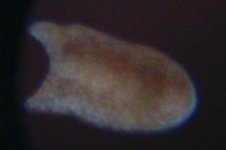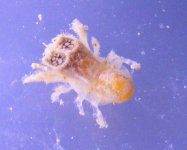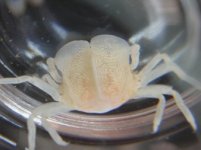You are using an out of date browser. It may not display this or other websites correctly.
You should upgrade or use an alternative browser.
You should upgrade or use an alternative browser.
Recent content by LeslieH1
-
Id Lobster?
It's a juvenile Panulirus, possibly ornatus. The color is variable and it changes as the animal grows. Here's an adult http://www.scuba-equipment-usa.com/mari ... us%29.html Lobsters are not reef safe. They're omnivorous eating machines. They prefer other crustaceans & fish but if their...- LeslieH1
- Post #2
- Forum: Coral, Rock and Sand Hitchhikers
-
Another Brittle Star
A picture and information about it's origin would be helpful. :)- LeslieH1
- Post #2
- Forum: Coral, Rock and Sand Hitchhikers
-
Hitchhiker
It's a female Coralliocaris shrimp. There are several species and without a better picture I can't tell which one it is. Like acro crabs they are obligate symbionts of acropora & related corals. My friend Art has a good image of one species here http://www.flickr.com/photos/artour_a/243275702/- LeslieH1
- Post #3
- Forum: Coral, Rock and Sand Hitchhikers
-
I have many pics and vids of various bugs!
Tom, that's absolutely invaluable information for reefers, thank you. I'm sure everyone who reads it will be extremely happy that you answered a year-old post. Perhaps this would take too much time but including the same information on your website for future reference would be a great service...- LeslieH1
- Post #15
- Forum: Coral, Rock and Sand Hitchhikers
-
I have many pics and vids of various bugs!
From reading the various posts about flatworms "plagues" the main concerns people have are 1) will they damage my corals? 2) will they eat something beneficial? 3) will they produce toxins when they die - especially if there's a lot of them? 4) they're ugly & icky. Reef wisdom says that...- LeslieH1
- Post #12
- Forum: Coral, Rock and Sand Hitchhikers
-
Umm, mind telling me what THIS is??
It's a commensal crab in the family Cryptochiridae, in the genus Fizsereneia. These called coral gall crabs because the females settle on corals, causing the corals to grow over them & form galls. I know a researcher who would LOVE to have the critter if you want to get rid of it. You can...- LeslieH1
- Post #8
- Forum: Coral, Rock and Sand Hitchhikers
-
I have many pics and vids of various bugs!
Back at ya, Tom :) Folks - Tom is THE expert on Convolutriloba and even has a picture key on the 4 known species on his web site. And if you want to know how species are defined check out his latest paper http://www.mapress.com/zootaxa/2007f/zt01525p017.pdf It's on the nifty new species Tom...- LeslieH1
- Post #10
- Forum: Coral, Rock and Sand Hitchhikers
-
White Crab ate Scallop.. help identify!
So maybe they hatched? ;) Experts have their specialties both in terms of the groups they work on and the areas they work in. If I had an odd crab from the Pacific northwest Greg Jensen would be my first choice for an id because he's worked on this fauna for 30 years. I wouldn't ask someone...- LeslieH1
- Post #21
- Forum: Coral, Rock and Sand Hitchhikers
-
White Crab ate Scallop.. help identify!
thanks Beth. If Shane says its a Durckheimia that's good enough for me. He is one of the world experts on the group and is certainly more likely to recognize it than anyone else who answered your emails. I see Greg & one other went with D. caeca. Eggs change color as they develop so the...- LeslieH1
- Post #19
- Forum: Coral, Rock and Sand Hitchhikers
-
White Crab ate Scallop.. help identify!
Hi Beth -- did you ever get a reply? I'm curious to know what it is and what the experts thought about the behavior.- LeslieH1
- Post #17
- Forum: Coral, Rock and Sand Hitchhikers
-
White Crab ate Scallop.. help identify!
If it dies and you see it before something scavenges the body throw it into a container filled with 70% or higher percentage alcohol. Everclear, rubbing alcohol, or a high proof clear liquor like Baccardi 151 white rum are acceptable. Let it sit overnight, drain off the alcohol, then refill...- LeslieH1
- Post #15
- Forum: Coral, Rock and Sand Hitchhikers
-
White Crab ate Scallop.. help identify!
Hi Beth -- It's very clearly a female whose protruding abdomen is full of eggs to the point where the crab plops forward rather than remain upright. Some species are sexually dimorphic in that the females which stay in the host for their entire lives look quite a bit different from the males...- LeslieH1
- Post #12
- Forum: Coral, Rock and Sand Hitchhikers
-
White Crab ate Scallop.. help identify!
Durckheimia caeca may not be a rare crab but because of its life inside flame scallops it's not seen or photographed very often. Here's a line drawing of one http://www.bioone.org/perlserv/?request ... -1-116-f03 If you have access to a library or ejournals check out Journal of Crustacean...- LeslieH1
- Post #10
- Forum: Coral, Rock and Sand Hitchhikers
-
some sort of isopod?
Mysids swim, isopods for the most part crawl. Mysid legs are tucked under the body & not visible from above while munnid isopod legs are spread out on either side of the body just as in the photographs.- LeslieH1
- Post #7
- Forum: Coral, Rock and Sand Hitchhikers
-
some sort of isopod?
Isopods, maybe munnids. harmless & fish food.- LeslieH1
- Post #5
- Forum: Coral, Rock and Sand Hitchhikers









